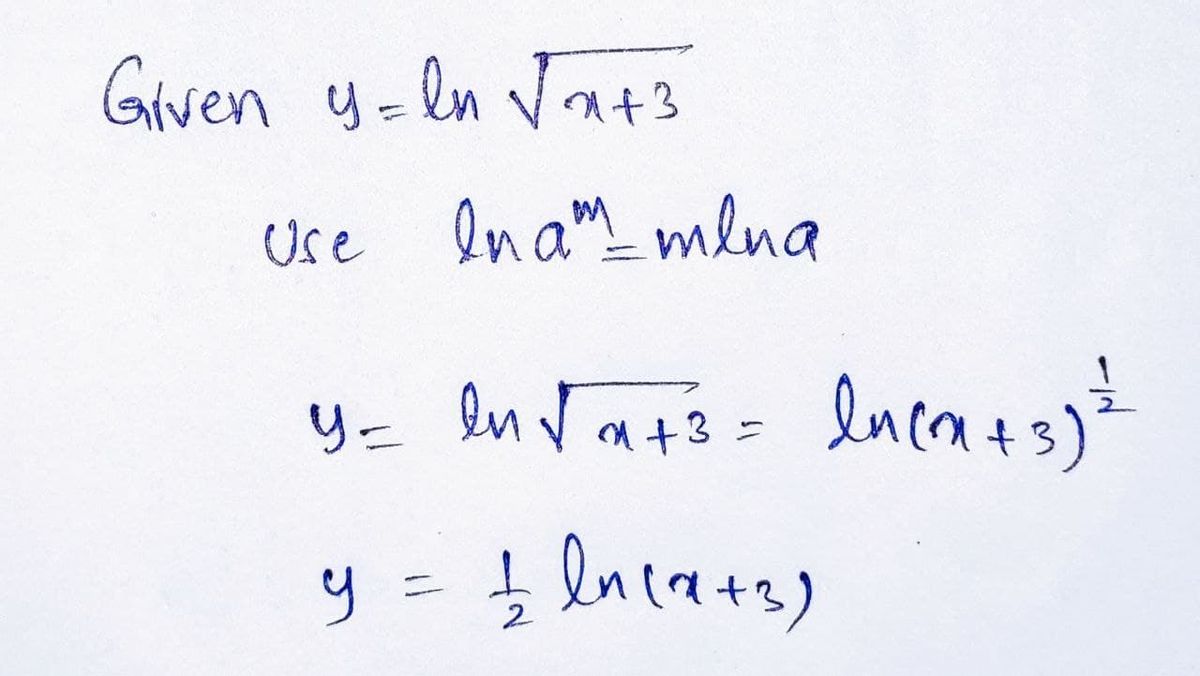Calculus: Early Transcendentals
8th Edition
ISBN:9781285741550
Author:James Stewart
Publisher:James Stewart
Chapter1: Functions And Models
Section: Chapter Questions
Problem 1RCC: (a) What is a function? What are its domain and range? (b) What is the graph of a function? (c) How...
Related questions
Question
4.5 4
![### Problem Statement
**Find the derivative:**
Given the function:
\[ y = \ln \sqrt{x + 3} \]
**Find \( y' \):**
\[ y' = \boxed{\ } \]
### Solution Steps
To find the derivative of the given function, follow these steps:
1. **Express the Square Root as a Power:**
- Rewrite \(\sqrt{x + 3}\) as \((x + 3)^{1/2}\).
2. **Use the Chain Rule:**
- Apply the derivative rule for logarithms: \(\frac{d}{dx} [\ln u] = \frac{1}{u} \cdot \frac{du}{dx}\), where \(u = (x + 3)^{1/2}\).
3. **Differentiate the Inner Function:**
- Calculate the derivative of the inner function: \(u = (x + 3)^{1/2}\).
- Use the power rule: \(\frac{d}{dx}[u] = \frac{1}{2}(x + 3)^{-1/2} \cdot \frac{d}{dx}[x + 3]\).
- Since \(\frac{d}{dx}[x + 3] = 1\), the derivative of the inner function becomes: \(\frac{1}{2}(x + 3)^{-1/2}\).
4. **Combine the Derivatives:**
- Substitute back into the chain rule result to get the full derivative of \(y\).
### Final Derivative
\[ y' = \frac{1}{(x + 3)^{1/2}} \cdot \frac{1}{2}(x + 3)^{-1/2} \]
\[ y' = \frac{1}{2(x + 3)} \]
Thus, the derivative \( y' \) is \(\frac{1}{2(x + 3)}\).](/v2/_next/image?url=https%3A%2F%2Fcontent.bartleby.com%2Fqna-images%2Fquestion%2F34d89729-f0b7-4660-b47f-8f1bb9a32e44%2F23029b18-a22c-4feb-82dd-52c03d96af04%2Fyyr60gr_processed.jpeg&w=3840&q=75)
Transcribed Image Text:### Problem Statement
**Find the derivative:**
Given the function:
\[ y = \ln \sqrt{x + 3} \]
**Find \( y' \):**
\[ y' = \boxed{\ } \]
### Solution Steps
To find the derivative of the given function, follow these steps:
1. **Express the Square Root as a Power:**
- Rewrite \(\sqrt{x + 3}\) as \((x + 3)^{1/2}\).
2. **Use the Chain Rule:**
- Apply the derivative rule for logarithms: \(\frac{d}{dx} [\ln u] = \frac{1}{u} \cdot \frac{du}{dx}\), where \(u = (x + 3)^{1/2}\).
3. **Differentiate the Inner Function:**
- Calculate the derivative of the inner function: \(u = (x + 3)^{1/2}\).
- Use the power rule: \(\frac{d}{dx}[u] = \frac{1}{2}(x + 3)^{-1/2} \cdot \frac{d}{dx}[x + 3]\).
- Since \(\frac{d}{dx}[x + 3] = 1\), the derivative of the inner function becomes: \(\frac{1}{2}(x + 3)^{-1/2}\).
4. **Combine the Derivatives:**
- Substitute back into the chain rule result to get the full derivative of \(y\).
### Final Derivative
\[ y' = \frac{1}{(x + 3)^{1/2}} \cdot \frac{1}{2}(x + 3)^{-1/2} \]
\[ y' = \frac{1}{2(x + 3)} \]
Thus, the derivative \( y' \) is \(\frac{1}{2(x + 3)}\).
Expert Solution
Step 1

Step by step
Solved in 2 steps with 2 images

Recommended textbooks for you

Calculus: Early Transcendentals
Calculus
ISBN:
9781285741550
Author:
James Stewart
Publisher:
Cengage Learning

Thomas' Calculus (14th Edition)
Calculus
ISBN:
9780134438986
Author:
Joel R. Hass, Christopher E. Heil, Maurice D. Weir
Publisher:
PEARSON

Calculus: Early Transcendentals (3rd Edition)
Calculus
ISBN:
9780134763644
Author:
William L. Briggs, Lyle Cochran, Bernard Gillett, Eric Schulz
Publisher:
PEARSON

Calculus: Early Transcendentals
Calculus
ISBN:
9781285741550
Author:
James Stewart
Publisher:
Cengage Learning

Thomas' Calculus (14th Edition)
Calculus
ISBN:
9780134438986
Author:
Joel R. Hass, Christopher E. Heil, Maurice D. Weir
Publisher:
PEARSON

Calculus: Early Transcendentals (3rd Edition)
Calculus
ISBN:
9780134763644
Author:
William L. Briggs, Lyle Cochran, Bernard Gillett, Eric Schulz
Publisher:
PEARSON

Calculus: Early Transcendentals
Calculus
ISBN:
9781319050740
Author:
Jon Rogawski, Colin Adams, Robert Franzosa
Publisher:
W. H. Freeman


Calculus: Early Transcendental Functions
Calculus
ISBN:
9781337552516
Author:
Ron Larson, Bruce H. Edwards
Publisher:
Cengage Learning